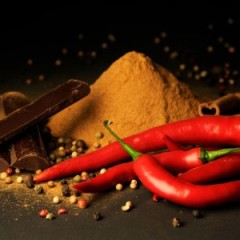Jo Malone just launched her limited-edition Spring collection of perfumes inspired by British cakes and desserts. The collection is called “Sugar & Spice” and numbers five fragrances in all, each in the super light cologne concentration.
According to Basenotes, the perfumer is Christine Nagel of Mane who “spent time with the Jo Malone Creative Studio eating cake in Fortnum and Masons, Claridges and various other fine cake establishments to familiarise herself with the local sweet treats.” The line includes: Redcurrant & Cream, Ginger Biscuit, Lemon Tart, Bitter Orange & Chocolate and Elderflower & Gooseberry.
The company has really outdone itself with the campaign for this collection. There is a really fun, bubbly, happy video (see midway down below) featuring Adam Ant’s famous 80s hit, Goody Two Shoes, and also, just in case you missed the food aspects to the collection, the company also released four dessert recipes to accompany the fragrances. (I couldn’t find one for Bitter Orange & Chocolate.) You can find the compiled list of all of them at The Daily Mail, though I will provide the direct link to the appropriate recipe in each fragrance’s discussion section.
I have samples of all five colognes, and I’ll review two of them — Ginger Biscuit and Bitter Orange & Chocolate — in this post. You can find my reviews for the other three perfumes in the collection — Elderflower & Gooseberry, Lemon Tart, and Redcurrant & Cream — here.
GINGER BISCUIT:
The Jo Malone website describes Ginger Biscuit as follows:
Just-baked biscuit. Spiced with ginger, nutmeg and cinnamon, melting into caramel. Butter-crumbly with roasted hazelnuts. Warmed by tonka bean and vanilla. Irresistible.
According to Basenotes, the perfumer, Christine Nagel, had the following vision in mind for the fragrance:
‘I wanted to recreate the equivalent deliciousness of a just baked biscuit enlivened with grated ginger.’ says Nagel, ‘Texture was important in this fragrance; the sharp natural note of ginger is set against the sensation of a baked, crumbly biscuit.’
Notes include ginger, nutmeg and cinnamon, caramel, roasted hazelnuts, tonka bean and vanilla.
Ginger Biscuit opens on my skin with a strong note of aldehydes. You can read more about aldehydes and the role they play in perfumery in the Glossary linked at the very top of the page, but, in a nutshell and the simplest terms, aldehydes smell soapy and/or waxy. Here, both aspects are present, though the soap eventually fades after about ten minutes. In those opening minutes, there is also the smell of warm cookies. There are definite and strong notes of vanilla, followed soon thereafter by a light touch hazelnut. Ginger Biscuit smells essentially just like a cookie or biscuit candle, only about a thousand times milder and lighter.
Unfortunately, soon thereafter, something else becomes much more dominant than hazelnut or sweet cookies. There is now a strong note of alcohol — as in rubbing alcohol. Its sharpness makes me think that the “ginger” component is extremely artificial and synthetic. While you can smell ginger, fleetingly, underneath or around it, the note is much more like disinfectant mixed in with vanilla.
I’m rather horrified. It feels exactly like you’ve gone to the doctor’s office and the nurse has swabbed your arm before taking blood with some antiseptic, except, here, it happens to be cloaked in cheap vanilla. If this is “ginger,” then you can get much more genuine and natural-smelling ginger in some of the pre-packaged jars in your supermarket.
On the barely more positive side, the whole damn perfume is so bloody light and ephemeral, you have to practically douse yourself and wolf at your arm to have much hope of smelling anything detailed. And I’m talking about the very first few minutes here! From a distance of about a foot away, you can smell some extremely generic wafts of vanilla and rubbing alcohol. Further than that, and I wouldn’t count on it for the average spray or two.
After the first twenty minutes, the perfume’s low sillage becomes even less. Then, thankfully, shortly before the second hour, the whole thing dies away entirely. It never changed much beyond the main vanilla and alcohol scent I described above, adding a whole new twist on simple, minimalistic and linear.
Lest it was not clear from this review, I think this is a horribly cheap-smelling, synthetic fragrance. I find it revolting, and I think even Bath & Body Works has better cookie or vanilla “fragrance sprays.” They cost about $14 for 8 oz which is about 7 more ounces than this stuff. For example, one of their vanilla fragrance sprays is Warm Vanilla Sugar. It doesn’t have “ginger” in it but, if we’re using Ms. Nagel’s definition of “ginger,” that’s just as well. I’ve smelled a lot of ginger in a lot of perfumes, and what’s in Ginger Biscuit does not seem at all like real, genuine-smelling, good ginger but, rather, like something concocted in a lab. Warm Vanilla Sugar is hardly the best vanilla cookie scent I’ve tried but it’s extremely affordable, lacks the screechingly sharp disinfectant note, and is a damn sight better than Ginger Biscuit, in my opinion. Plus, the Bath & Body Works fragrances don’t have a soapy undertone in the opening minutes.
I cannot believe Jo Malone is asking $60 for this. And for a miniscule bottle, to boot! Outrageous.
To wipe away the bad taste of cheap chemicals, I suggest watching the wonderful, incredibly fun, bubbly video launched as part of the Jo Malone ad campaign for the “Sugar and Spice” collection. It shows all the makeup and food they used in a “behind the scenes” look. Plus, the classic Adam Ant song is always an incredibly peppy and cheerful way to brighten your day:
Finally, if the perfume isn’t your cup of tea (and I really hope it isn’t), you can always try making the recipe for Stem Ginger Biscuits which can be found at this Daily Mail page.
BITTER ORANGE & CHOCOLATE:
Jo Malone’s website describes Bitter Orange & Chocolate as follows:
The bite of bitter orange, layered with dark chocolate. Orange peel counterpoised with warm, powdery cocoa, milky coconut and coumarin. Sumptuous and addictive.
Basenotes quotes Nagel as saying,
[this fragrance is] very special and unexpected. Orange is a classic raw material for a perfumer so we chose to shake things up with a mix of bitter and sweet orange notes. When combined with the chocolate many interesting qualities began to develop. The chocolate is dark, powdery and creamy but the orange adds energy and bite.
Bitter Orange & Chocolate opens with an absolutely gorgeous note of rich orange peel and the darkest of bitter chocolate. The orange is sweet, heady and reminiscent of the Seville oranges used in marmalade, only more slightly sugared. It is mouth-watering, delicious, and a simply lovely, lovely note! The chocolate is simultaneously like the dark slabs used in baking but, after ten minutes, it’s also like hot chocolate.
As time passes, the chocolate note starts to dominate, adding an occasionally dusty cocoa powder appearance to its other two faces. The orange recedes (alas) to the background, popping up in visibility for brief moments here or there, but generally content to let the chocolate take the lead in this dance. I don’t smell any coconut, milky or otherwise. After thirty minutes, there is the vaguest hint of coumarin that starts to pop up. This version of it is sweet and faintly hay-like, but also with vanilla undertones. The coumarin is very subtle, yet it adds an interesting subtext of dryness to counter the sweet overtones. In its final stage, the perfume turns into a sheer veil of powdered chocolate with some coumarin.
The whole thing is very light, sheer and subtle, with minimal projection. You can detect definite whiffs of it in the opening minutes from about half a foot away. Perhaps less. Soon thereafter, you can still smell it if you bring your arm a few inches away from your nose. At the thirty minute mark, you have to put your wrist right under your nose to detect it, and it becomes even more minimal after that. Its duration was much shorter than some of the fragrances in the line: the fragrance died away entirely after about 1.5 hours.
All in all, Bitter Orange & Chocolate was my favorite out of the collection. I say that not only because I have an oft-repeated love for orange notes but, also, because this fragrance lacked some of the serious deficiencies of the others in the line. It was neither too, too sweet, nor too artificial and chemical-smelling. There were no notes of sharp disinfectant, soap, or synthetics. It was lovely and well-balanced. It’s not a particularly complicated scent — but, then, it wasn’t trying to be.
The problem is that $60 is a lot for a fragrance that is both very simple and of very short duration. Bitter Orange & Chocolate lasted around 1.5 hours on me, and was barely detectable for much of that time unless I jammed my arm under my nose. Some people don’t mind re-application of their scents, but a 90-minute benchmark requires a lot of re-spraying! Even if someone has skin that doesn’t go through perfume as quickly as mine, Jo Malone fragrances are NOT known for their longevity as a whole. So, when your $60 bottle is a tiny 1 oz., those constant re-applications will finish things off quickly and makes the perfume a bit more costly than it might otherwise appear.
I read somewhere that Jo Malone representatives suggest layering some of these scents with others from her Tea Fragrance Blends collection. That’s fine, and should help in adding some minor modicum of complexity or depth to some of the scents. The problem is, that Tea collection was from 2011 and is no longer available. But even if it were, or even if you used the current Earl Grey & Cucumber fragrance (which is all that remains available from that collection), perfumes can and should be judged on their own merits. They should not be assessed based on how they smell by buying another $60 bottle to help things along. Besides, I highly doubt that layering would significantly change the duration problem.
Like all the fragrances in the collection, Bitter Orange & Chocolate doesn’t suit my personal style or taste, but it is definitely the one I would recommend the most out of the five. You can find my reviews for the other three fragrances in the collection here.












